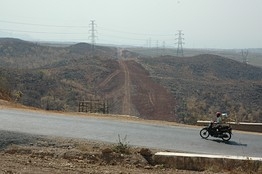
A new crude oil pipeline through Myanmar due to begin operations in September will put China in a favorable position compared to other Asian economic powerhouses challenged by energy security issues.
穿過(guò)緬甸的一條新原油管線定于9月開(kāi)始運(yùn)營(yíng),相比其他面臨能源安全問(wèn)題挑戰(zhàn)的亞洲經(jīng)濟(jì)強(qiáng)國(guó),這條管線將讓中國(guó)處于有利地位。
At a capacity of 440,000 barrels a day, the pipeline--running from Myanmar's coast at the Bay of Bengal to China's southern Yunnan region--will allow China to send less crude through the Strait of Malacca. The narrow waterway by Singapore, where the U.S. Navy has a strong presence, is considered a major threat to secure energy supplies by major Asian economies dependent on crude shipments from the Middle East and Africa.
這條從緬甸位于孟加拉灣的海岸線到中國(guó)南方云南地區(qū)的管線每天可輸送44萬(wàn)桶原油,讓中國(guó)得以減少通過(guò)馬六甲海峽運(yùn)輸?shù)脑蛿?shù)量。對(duì)于依賴從中東和非洲運(yùn)輸原油的亞洲經(jīng)濟(jì)體來(lái)說(shuō),毗鄰新加坡的狹窄航道馬六甲海峽被認(rèn)為是對(duì)安全能源供應(yīng)的重大威脅。美國(guó)海軍在新加坡駐有重兵。
China--helped by its own domestic oil production of just over 4 million barrels a day--last year relied on the narrow waters for around 37% of its total demand. That share will drop to about 30% once the Myanmar pipeline comes on stream.
在每天略高于400萬(wàn)桶的國(guó)內(nèi)原油生產(chǎn)的幫助下,中國(guó)去年依賴馬六甲海峽運(yùn)輸?shù)脑驼计淇傂枨蟮?7%左右。一旦緬甸的管線投入使用,這個(gè)比例將下降到30%左右。
In comparison, Japan, South Korea and Taiwan all rely on the Strait of Malacca for around 75% of their total oil consumption, in part due to their small domestic production.
相比之下,日本、韓國(guó)和臺(tái)灣地區(qū)石油消耗總量的75%依靠馬六甲海峽運(yùn)輸,部分原因是其國(guó)內(nèi)原油產(chǎn)量很小。
The Myanmar pipeline, which will run parallel to a major natural gas pipeline, comes on top of a string of oil and gas import pipelines already completed or planned to supply China's less-developed inland regions.
緬甸原油管線與一條重要天然氣管線平行,在此之前已經(jīng)有一系列向中國(guó)欠發(fā)達(dá)內(nèi)陸地區(qū)輸送油氣的已完工或規(guī)劃中的油氣進(jìn)口管線。
In 2009, a new pipeline from Russia began pumping Siberian crude into northern China, and in March this year, the two countries agreed to double shipments to 620,000 barrels a day. They also agreed in principle on a new pipeline that will feed northeastern China with 38 billion cubic meters of Russian natural gas a year starting in 2018.
2009年,一條從俄羅斯起始的新管線開(kāi)始將西伯利亞原油輸送到中國(guó)北部,今年3月,中俄兩國(guó)達(dá)成協(xié)議,將輸送的原油數(shù)量增加一倍,至每天62萬(wàn)桶。兩國(guó)還大體上就新建一條天然氣管線達(dá)成協(xié)議,該管線將從2018年起每年向中國(guó)東北輸送380億立方米俄羅斯天然氣。
Also in 2009, a pipeline began operations that stretches 4,000 kilometers across Central Asia and is capable of shipping 30 billion cubic meters of gas a year from Turkmenistan to western China. Oil imports from neighboring Kazakhstan began in 2005, and are set to double to 400,000 barrels a day when expansion at an existing pipeline is completed next year.
同樣在2009年,一條綿延4,000公里、橫貫中亞的管線開(kāi)始運(yùn)行,這條管線每年能夠從土庫(kù)曼斯坦向中國(guó)西部輸送300億立方米天然氣。從哈薩克斯坦進(jìn)口石油從2005年開(kāi)始,而且進(jìn)口量將在明年一條現(xiàn)有管線完成擴(kuò)容后增加一倍,達(dá)到每天40萬(wàn)桶。
While the oil pipeline could reach full capacity soon after launch, the gas pipeline is not expected to be filled until Myanmar ramps up production from its offshore fields. Furthermore, the Wood Mackenzie energy consultancy estimates that CNPC is building the pipelines through Myanmar at a short-term loss, as it will buy gas at market price and sell it at subsidized prices at home.
雖然緬甸的石油管線可能在投入使用后不久達(dá)到滿負(fù)荷運(yùn)行,但天然氣管線預(yù)計(jì)在緬甸加強(qiáng)其海上氣田生產(chǎn)之前將無(wú)法發(fā)揮全部產(chǎn)能。此外,能源咨詢機(jī)構(gòu)Wood Mackenzie估計(jì),中國(guó)石油天然氣集團(tuán)公司(CNPC)是以短期虧損為代價(jià)修建通過(guò)緬甸的管線,因該公司將以市場(chǎng)價(jià)購(gòu)買天然氣,然后在國(guó)內(nèi)以補(bǔ)貼價(jià)出售。
'The Chinese are willing and capable of taking a long-term view,' said Wood Mackenzie analyst Craig McMahon.
Wood Mackenzie分析師麥克馬洪(Craig McMahon)說(shuō),中國(guó)人愿意從長(zhǎng)遠(yuǎn)角度看問(wèn)題,也有能力這樣做。


